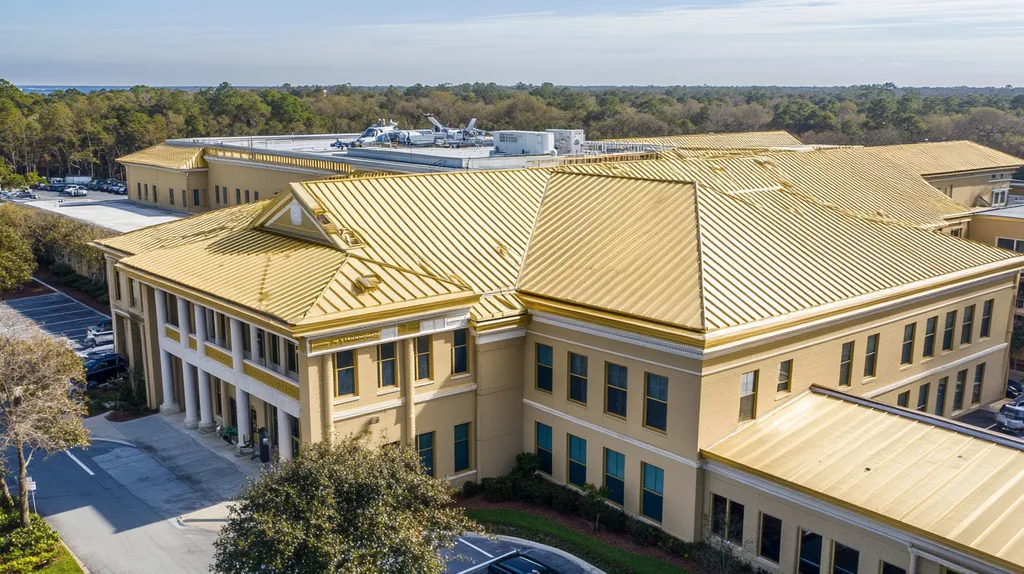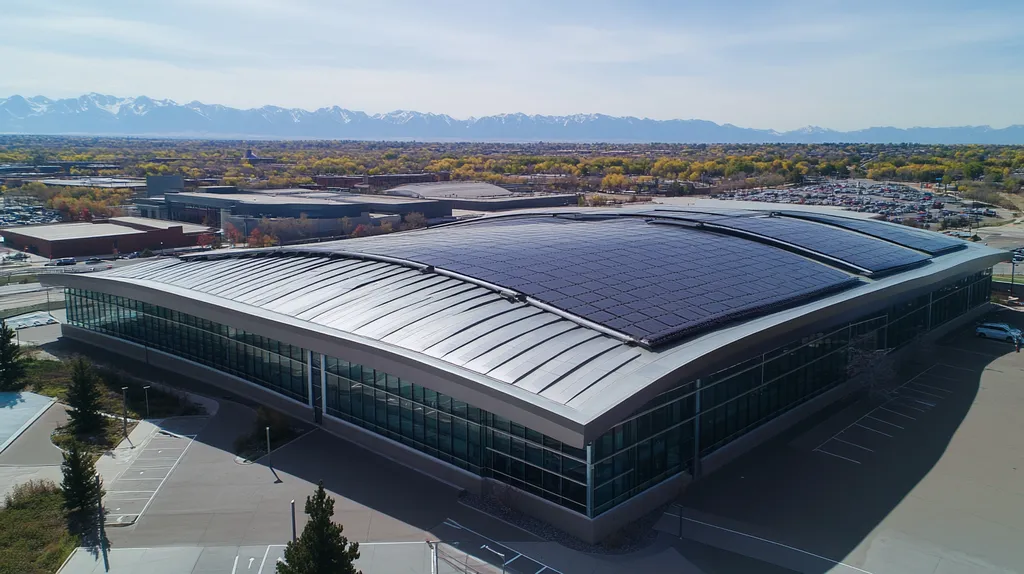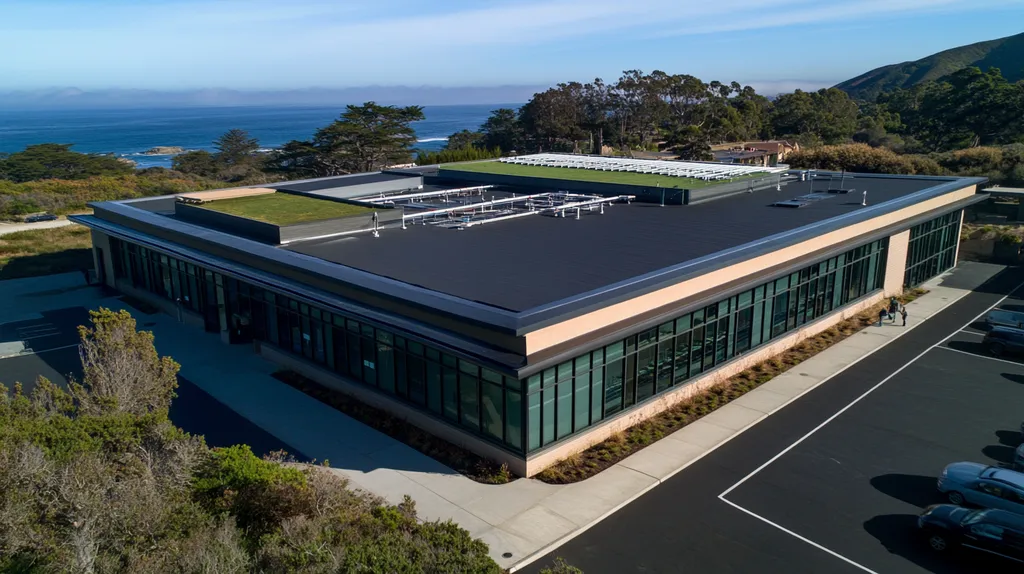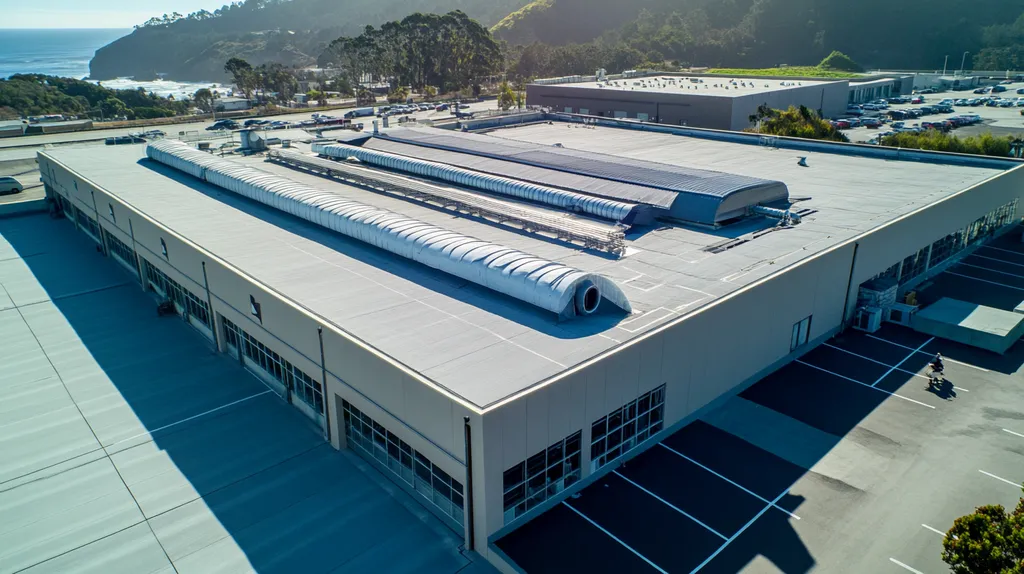Industrial roofing installations generate over 8 million tons of landfill waste annually while consuming massive amounts of energy through inefficient designs and materials. This environmental impact carries both ethical and financial consequences for facility owners.
Modern eco-friendly roofing alternatives offer dramatic improvements, reducing energy costs by up to 30% while diverting thousands of pounds of waste from landfills per installation. Recent advances in sustainable materials and installation techniques have made these options increasingly accessible and cost-effective.
This comprehensive guide examines critical factors facility managers must consider when evaluating sustainable roofing solutions, from material selection to long-term performance metrics.
SECTION 1: THE BASICS EXPLAINED
The industrial roofing sector stands at a critical environmental crossroads. Traditional roofing materials and methods contribute significantly to landfill waste, while rising energy costs strain facility budgets. Modern eco-friendly roofing solutions offer a path forward, combining environmental responsibility with operational efficiency. Understanding these sustainable options has become essential for property owners seeking to reduce costs, meet regulations, and minimize environmental impact.
What It Is (In Plain Language)
Eco-friendly industrial roofing integrates sustainable materials and innovative technologies that minimize environmental impact while maximizing building performance. These systems include recycled materials, reflective coatings, and plant-based solutions that work together to reduce energy consumption and waste.
The roofing industry has evolved to incorporate sustainable options like recycled materials and solar-ready installations, marking a significant shift toward environmental responsibility. Modern solutions now emphasize both immediate performance and long-term sustainability. (source: Castagra)
These systems often feature modular components that can be easily repaired or recycled, reducing waste during maintenance and eventual replacement. Each element serves multiple purposes, from managing stormwater to reflecting solar heat.
Key features typically include enhanced insulation properties, renewable material content, and strategic design elements that extend the roof’s functional lifespan. These characteristics work together to create a comprehensive sustainability solution.
Why It Matters (To Your Building)
Sustainable roofing directly impacts your facility’s bottom line through reduced energy costs and extended service life. Buildings with eco-friendly roofs typically see a 25-30% reduction in cooling expenses during summer months.
These systems also enhance property value by meeting or exceeding increasingly strict environmental building codes. Many regions now offer tax incentives and expedited permits for buildings incorporating sustainable roofing solutions.
Maintenance costs decrease significantly with eco-friendly systems, as they’re engineered for durability and easier repairs. Their resistant materials and smart design principles reduce the frequency and scope of necessary maintenance.
Additionally, sustainable roofs help protect against future regulatory changes while positioning your property as environmentally responsible. This forward-thinking approach often translates into higher occupancy rates and rental premiums.
How It Works
Eco-friendly roofing systems function through a combination of material science and architectural design. They utilize specialized coatings and materials that reflect solar radiation, reducing heat absorption and lowering cooling demands.
Advanced insulation layers work in concert with reflective surfaces to maintain consistent interior temperatures. This thermal management occurs passively, requiring no additional energy input.
Water management features channel precipitation efficiently while filtering pollutants. Many systems incorporate retention areas that slowly release water, reducing strain on municipal storm systems.
The integration of recyclable and renewable materials ensures that when components need replacement, they can be processed responsibly. This closed-loop approach minimizes waste throughout the roof’s lifecycle.
SECTION 2: PRACTICAL APPLICATIONS
Industrial roofing decisions today carry unprecedented environmental and financial weight. With heating and cooling costs accounting for up to 40% of commercial energy consumption, sustainable roofing choices directly impact both operational expenses and environmental footprint. Modern eco-friendly solutions offer dramatic improvements – reflective coatings can reduce peak cooling demands by 15-25%, while integrated solar solutions generate clean energy while protecting the roof structure.
Common Uses & Examples
Manufacturing facilities and warehouses represent prime candidates for eco-friendly roofing installations. Their large, flat surfaces provide ideal conditions for sustainable solutions like cool roofs and solar integration.
Distribution centers frequently utilize white TPO or PVC membranes to reflect solar radiation. These materials can maintain surface temperatures 50-60°F cooler than traditional dark roofs during peak summer conditions.
Food processing facilities often combine reflective membranes with enhanced insulation systems. This pairing helps maintain consistent interior temperatures while reducing HVAC load.
Cold storage warehouses increasingly adopt multi-layer sustainable systems. These incorporate vapor barriers, high-R-value insulation, and reflective top layers to minimize thermal transfer and energy consumption.
When You Need It Most
Facility expansion or renovation presents an ideal opportunity to implement eco-friendly roofing. The incremental cost difference during new construction is typically offset within 3-5 years through reduced operating expenses.
Emergency repairs or replacements due to storm damage create another critical decision point. Upgrading to sustainable materials during these necessary repairs can transform a liability into a long-term asset.
Solar panel installations on existing roofs require careful evaluation of the underlying structure. In most cases, solar panels provide excellent electricity production while extending roof life through additional protection and shade. (source: Nations Roof)
Budget planning cycles offer strategic timing for sustainable upgrades. Many facilities can leverage tax incentives and utility rebates by timing installations to align with fiscal calendars.
Interactions With Other Systems
Sustainable roofing works synergistically with building automation systems. Smart controls can optimize HVAC operation based on roof surface temperatures and conditions.
Modern stormwater management systems benefit from eco-friendly roofing features. Retention areas and filtered drainage paths reduce burden on municipal infrastructure while improving water quality.
Building envelope monitoring systems provide real-time data on roof performance. This allows facility managers to quantify energy savings and identify maintenance needs before they become costly repairs.
Fire suppression systems maintain full functionality with eco-friendly roofing. Many sustainable materials offer equivalent or superior fire ratings compared to traditional options.
SECTION 3: KEY TERMINOLOGY DECODED
The complexity of roofing terminology often creates barriers to implementing sustainable solutions. With industrial facilities accounting for nearly 30% of commercial energy consumption, understanding these terms directly impacts both environmental outcomes and operational costs. Modern sustainable roofing combines advanced materials, innovative technologies, and precise measurements – each with its own specialized vocabulary that facility managers must master.
Essential Terms Explained
Sustainable coatings represent one of the most accessible entry points to eco-friendly roofing. These specialized materials can reduce solar heat absorption by 20-50% while providing superior protection against environmental damage. (source: Castagra)
Vegetative or “green” roofing systems incorporate living plants and growing media. These systems provide natural insulation, manage stormwater runoff, and create wildlife habitats while extending roof membrane life by protecting it from UV exposure.
Cool roofing technologies utilize specialized pigments and reflective materials. These surfaces maintain temperatures 50-70°F cooler than traditional dark roofs during peak summer conditions, dramatically reducing cooling loads.
Solar-ready design ensures roofing systems can accommodate future photovoltaic installations. This includes enhanced structural support, appropriate membrane selection, and strategic placement of roof penetrations.
Industry Jargon Translated
Thermal resistance (R-value) measures a material’s ability to resist heat flow. Higher R-values indicate better insulation performance, with modern sustainable systems often achieving twice the R-value of conventional roofing.
Solar Reflectance Index (SRI) quantifies a surface’s ability to reject solar heat. This measurement combines solar reflectance and thermal emittance into a single value, with higher numbers indicating better heat rejection.
Building-Integrated Photovoltaics (BIPV) describes roofing materials that generate electricity while functioning as traditional roofing. These systems eliminate the need for separate panel mounting systems while maintaining watertight integrity.
Life Cycle Assessment (LCA) evaluates environmental impacts from material production through disposal. This analysis helps identify truly sustainable options by considering manufacturing energy, installation requirements, and end-of-life recyclability.
Measurement & Units Simplified
Roof area calculations use “squares” as the standard measurement unit. One square equals 100 square feet, helping contractors quickly estimate material requirements and costs.
Load capacity ratings specify maximum weight per square foot (psf). These calculations must account for both dead loads (permanent weight) and live loads (temporary weight from maintenance, snow, or equipment).
Energy performance metrics focus on kilowatt-hours (kWh) saved annually. These savings directly translate to reduced operational costs and decreased carbon emissions.
Warranty coverage typically spans 20-30 years for sustainable systems. Coverage terms often include specific performance guarantees for reflectivity, water tightness, and material integrity over the warranty period.
SECTION 4: DECISION FACTORS
The industrial roofing landscape is rapidly evolving as environmental concerns intersect with operational demands. With buildings accounting for nearly 40% of global energy consumption, choosing the right sustainable roofing solution has become a critical business decision. Modern eco-friendly options now offer compelling advantages in terms of cost savings, performance, and longevity – yet many facility managers struggle to evaluate these factors effectively.
Cost Considerations
Sustainable roofing materials typically require 15-25% higher initial investment compared to traditional options. However, this cost differential rapidly diminishes when factoring in energy savings, extended lifespan, and available incentives.
Light-colored coatings can reduce solar heat absorption by 20-50%, while using renewable materials like castor oil-based formulations delivers superior adhesion and durability. These eco-friendly coatings also improve indoor air quality through zero VOC emissions. (source: Castagra)
Federal, state, and local incentives can offset 30-50% of sustainable roofing costs through tax credits, rebates, and accelerated depreciation. Many utilities offer additional incentives for cool roof installations.
Maintenance costs typically run 25-40% lower for sustainable systems due to better durability and simpler repair requirements. This reduction in ongoing expenses significantly improves total cost of ownership.
Performance Trade-offs
Climate zone heavily influences sustainable roofing performance. Cool roofs deliver maximum benefit in cooling-dominated regions, while dark surfaces may be preferable in heating-dominated areas.
Structural capacity must be carefully evaluated, particularly for vegetative roofs that can weigh 10-30 pounds per square foot when saturated. Reinforcement costs should factor into overall project budgets.
Water management capabilities vary significantly between systems. Some materials excel at rapid drainage while others provide retention benefits, affecting stormwater compliance requirements.
Energy performance shows seasonal variation. While summer cooling savings can reach 25-30%, winter heating penalties may partially offset these gains in cold climates.
Lifespan & Durability Factors
Modern sustainable roofing systems routinely achieve 30-40 year lifespans, compared to 15-20 years for traditional materials. This extended service life dramatically improves return on investment calculations.
UV resistance varies significantly between materials. High-performance coatings and membranes can maintain reflectivity for 15+ years, while basic materials may degrade within 5-7 years.
Impact resistance becomes especially critical as extreme weather events increase in frequency. Many sustainable materials offer superior protection against hail and wind-driven debris.
Warranty terms often extend longer for sustainable systems, frequently reaching 25-30 years with material performance guarantees. This coverage helps protect the substantial upfront investment while ensuring long-term performance.
SECTION 5: COMMON CHALLENGES
Sustainable industrial roofing faces unique challenges that can compromise both environmental benefits and facility operations. While eco-friendly systems offer significant advantages, they require specialized knowledge and maintenance to perform optimally. Recent industry data indicates that up to 40% of sustainable roof installations experience preventable issues within their first five years, primarily due to improper maintenance or installation oversights.
Frequent Problems & Solutions
Material compatibility presents a significant challenge in sustainable roofing. Not all eco-friendly materials interact well with existing structural components or adjacent systems, potentially leading to premature deterioration or reduced effectiveness.
Temperature fluctuations can affect sustainable materials differently than traditional options. Extreme thermal cycling may cause more pronounced expansion and contraction, requiring specialized installation techniques and attachment methods.
Moisture management becomes particularly critical with sustainable systems. Many eco-friendly materials require precise moisture barriers and ventilation to maintain their insulative properties and prevent internal condensation.
Weight distribution often requires special consideration, especially with vegetative roofs or solar installations. Structural modifications may be necessary to support these sustainable additions while maintaining building integrity.
Warning Signs To Watch For
Surface degradation often manifests through uneven weathering or discoloration. These visual changes can indicate compromised reflective properties or material breakdown that affects energy efficiency.
Membrane separation at seams or flashings requires immediate attention. Even minor separations can allow moisture intrusion that compromises both insulation performance and structural integrity.
Changes in interior comfort levels or energy consumption patterns may signal roofing system issues. Sudden increases in HVAC loads often indicate diminished roof performance.
Water stains or dampness around roof penetrations deserve prompt investigation. These symptoms frequently indicate failing seals or improper flashing installation that can compromise the entire system.
Preventative Approaches
Regular inspections should focus on system-specific vulnerabilities. Quarterly assessments help identify potential issues before they develop into costly repairs or environmental compromises.
Staff training must emphasize the unique characteristics of sustainable materials. Maintenance personnel need specialized knowledge to properly care for these systems without inadvertently causing damage.
Documentation of all roofing activities helps track performance patterns. Detailed records enable better prediction of maintenance needs and help optimize the timing of preventive measures.
Environmental monitoring systems can provide early warning of potential issues. Sensors tracking temperature, moisture, and structural movement help prevent catastrophic failures while maintaining optimal performance.
SECTION 6: NEXT STEPS & RESOURCES
The transition to sustainable industrial roofing represents both an environmental imperative and a strategic opportunity. With buildings accounting for 40% of global energy consumption, choosing the right eco-friendly roofing solution has become critical for long-term facility management. Recent market analysis shows facilities with sustainable roofing systems achieve 25-35% lower operating costs while significantly reducing carbon emissions. Making informed decisions requires understanding key questions, standards, and learning resources.
Questions To Ask Providers
Start by examining a provider’s experience with sustainable installations similar to your facility type and size. Request specific performance data and case studies demonstrating successful implementations on comparable buildings.
Verify their familiarity with local building codes and environmental regulations. Providers should clearly explain how their solutions meet or exceed current standards while anticipating future requirements.
Evaluate their quality control processes and installation procedures. Ask about crew training, material handling protocols, and methods for protecting existing building components during installation.
Discuss their approach to project planning and risk management. Quality providers will present detailed timelines, contingency plans, and strategies for minimizing operational disruption.
Industry Standards & Guidelines
Sustainable roofing materials must meet rigorous performance criteria established by organizations like ASTM International and FM Global. These standards ensure reliability while validating environmental benefits.
The Cool Roof Rating Council (CRRC) provides independent performance ratings for reflective roofing products. Their database helps compare options based on solar reflectance and thermal emittance values.
LEED certification requirements offer comprehensive guidelines for sustainable roofing. Understanding these criteria helps align installation decisions with broader environmental goals.
The National Roofing Contractors Association (NRCA) maintains technical guidelines specifically for sustainable systems. These resources detail best practices for installation and maintenance.
Further Learning Simplified
Professional certification programs offer structured learning paths. Organizations like RCI (now IIBEC) provide specialized training in sustainable roofing design and installation.
Industry publications and technical bulletins deliver regular updates on emerging technologies and techniques. These resources help facility managers stay current with evolving best practices.
Sustainable coatings represent an accessible entry point for learning about eco-friendly options. These materials can reduce solar heat absorption by 20-50% while providing superior protection through renewable ingredients and improved adhesion. (source: Castagra)
Manufacturer training programs provide hands-on experience with specific sustainable systems. These sessions often include both classroom instruction and field demonstrations.
The Bottom Line
With industrial roofing waste filling landfills at a rate of 8 million tons annually, the environmental and financial stakes have never been higher.
Modern sustainable roofing solutions now deliver 30% energy savings while extending service life by 10-15 years compared to traditional systems.
The technology exists today to transform industrial roofs from environmental liabilities into high-performance assets that reduce costs, meet regulations, and minimize carbon footprint.
As material prices stabilize and installation expertise grows, the business case for sustainable industrial roofing has become impossible to ignore.
The question is no longer whether to adopt eco-friendly roofing, but how quickly facilities can implement these proven solutions to capture both environmental and financial benefits.
FREQUENTLY ASKED QUESTIONS
Q. What is eco-friendly roofing for commercial roofs?
A. Eco-friendly roofing integrates sustainable materials and technologies that lower environmental impact and enhance building performance.
Q. How do sustainable options benefit industrial roofs?
A. Sustainable options improve energy efficiency, reduce operational costs, and enhance property value over time.
Q. What are common terms related to industrial roofs?
A. Important terms include thermal resistance (R-value), solar reflectance index (SRI), and life cycle assessment (LCA).
Q. How do I evaluate my commercial roof’s longevity?
A. Consider materials used, warranty terms, and maintenance history to gauge potential lifespan and durability.
Q. What challenges may arise with sustainable industrial roofs?
A. Challenges include material compatibility, moisture management, and the need for regular inspections to avoid issues.
Q. How can I find resources for eco-friendly roofing?
A. Explore industry publications, training programs, and certification organizations to enhance your understanding of sustainable roofing.
Q. What are the costs associated with commercial roof installations?
A. Initial investments can be higher, but long-term savings on energy and maintenance can offset these expenses significantly.











